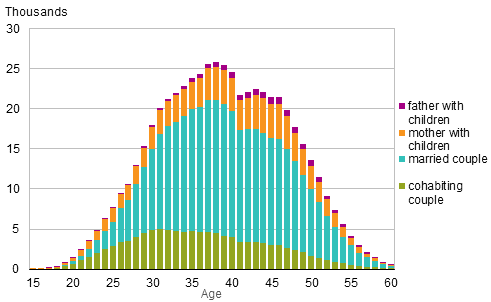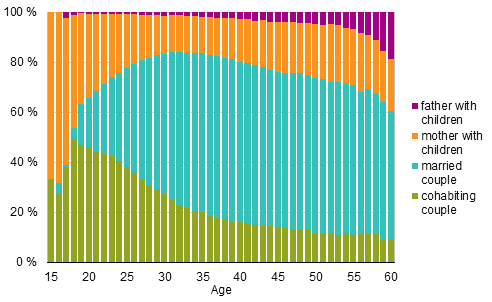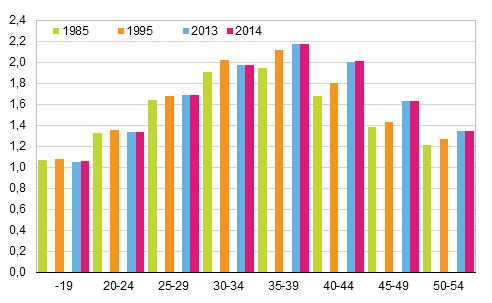3. Number of families with children goes on falling
At the end of 2014, there were 574,000 families with underage children in Finland. A family with underage children has at least one child under the age of 18 living at home. Families with underage children make up 39 per cent of all families. The percentage has been falling at a steady rate for the past few years. In all, 40 per cent of the population live in families with underage children, older siblings included.
The number of families with underage children fell by 2,100 from the previous year. The drop was 600 lower than in the year before. The number of families with children under the age of seven has increased by 314 families from the year before.
Table 5. Families with underage children by type in 1950–2014
| Year | Total | Married couple with children |
Cohabiting couple with children |
Mother and children |
Father and children |
Registered partnership with children |
Persons in families with underage children |
Families with children aged 17 or under |
Families with children of all families, % |
Population belonging to families with children, % |
| 1950 | 599 329 | 515 115 | .. | 74 319 | 9 895 | .. | .. | 1 341 330 | 64,4 | .. |
| 1960 | 678 046 | 601 542 | .. | 67 381 | 9 123 | .. | .. | 1 536 464 | 65,4 | .. |
| 1970 1) | 677 035 | 602 076 | 5 800 | 61 173 | 7 986 | .. | .. | 1 345 089 | 58,7 | .. |
| 1980 2) | 688 732 | 572 142 | 32 100 | 74 839 | 9 651 | .. | .. | 1 163 926 | 53,9 | .. |
| 1990 | 640 637 | 490 999 | 59 900 | 78 948 | 10 790 | .. | 2 437 592 | 1 135 686 | 46,9 | 48,8 |
| 2000 | 612 627 | 398 892 | 95 120 | 103 984 | 14 631 | .. | 2 317 291 | 1 116 687 | 43,7 | 44,7 |
| 2005 | 591 528 | 368 553 | 104 782 | 103 044 | 15 063 | 86 | 2 232 613 | 1 084 865 | 41,5 | 42,5 |
| 2010 | 582 360 | 356 943 | 107 368 | 101 946 | 15 836 | 267 | 2 200 603 | 1 068 554 | 40,0 | 40,8 |
| 2011 | 580 547 | 354 567 | 107 738 | 101 963 | 15 940 | 339 | 2 185 130 | 1 061 710 | 39,7 | 40,5 |
| 2012 | 578 409 | 352 159 | 107 751 | 102 013 | 16 081 | 405 | 2 176 199 | 1 058 664 | 39,5 | 40,1 |
| 2013 | 575 683 | 347 817 | 109 104 | 102 152 | 16 163 | 447 | 2 166 385 | 1 056 606 | 39,1 | 39,7 |
| 2014 | 573 566 | 343 428 | 110 069 | 103 115 | 16 430 | 524 | 2 158 867 | 1 055 763 | 38,9 | 39,5 |
| % | ||||||||||
| 1950 | 100,0 | 85,9 | .. | 12,4 | 1,7 | .. | .. | .. | .. | .. |
| 1960 | 100,0 | 88,7 | .. | 9,9 | 1,3 | .. | .. | .. | .. | .. |
| 1970 | 100,0 | 88,9 | 0,9 | 9,0 | 1,2 | .. | .. | .. | .. | .. |
| 1980 | 100,0 | 83,1 | 4,7 | 10,9 | 1,4 | .. | .. | .. | .. | .. |
| 1990 | 100,0 | 76,6 | 9,4 | 12,3 | 1,7 | .. | .. | .. | .. | .. |
| 2000 | 100,0 | 65,1 | 15,5 | 17,0 | 2,4 | .. | .. | .. | .. | .. |
| 2005 | 100,0 | 62,3 | 17,7 | 17,4 | 2,5 | 0,0 | .. | .. | .. | .. |
| 2010 | 100,0 | 61,3 | 18,4 | 17,5 | 2,7 | 0,0 | .. | .. | .. | .. |
| 2011 | 100,0 | 61,1 | 18,6 | 17,6 | 2,7 | 0,1 | .. | .. | .. | .. |
| 2012 | 100,0 | 60,9 | 18,6 | 17,6 | 2,8 | 0,1 | .. | .. | .. | .. |
| 2013 | 100,0 | 60,4 | 19,0 | 17,7 | 2,8 | 0,1 | .. | .. | .. | .. |
| 2014 | 100,0 | 59,9 | 19,2 | 18,0 | 2,9 | 0,1 | .. | .. | .. | .. |
2) The breakdown of the census by type of family has been revised on the basis of the 1981 register-based material on families and cohabiting couples.
3.1 Sixty per cent of families with underage children are families of married couples
The most common family with children is still that consisting of a married couple and children. In 60 per cent of all families with underage children the supporters are a married couple. On the other hand, this is the only form of family with children which has seen a steady decline, both in absolute and relative terms. Nevertheless, it is evident that its dominance is not threatened by other family forms for the time being. The numbers of all other types of families with children grew over the year. At the end of 2014, there were 110,100 families of cohabiting couples with underage children in Finland, which equals to 19 per cent of all families with underage children. Compared with 2013, the number of families of cohabiting couples increased by nearly 1,000.
Nowadays 56 per cent of firstborn children are born outside the marriage. The share has slowly increased, by six percentage points since 1997, when one-half of firstborn children were born outside the marriage. Forty-three per cent of all children born in 2014 were born outside the marriage.
The number of families formed by a mother and children has grown by nearly one thousand compared with 2013. At the end of 2014, families formed by mothers and children numbered around 103,000. Around one-fifth of all families with children are still one-parent families (mother and children or father and children). Families with children whose regular composition is father and children are still quite rare. There are only 16,400 such families. Families composed of a registered couple and children under the age of 18 are even rarer, numbering 524. Although the number of such families does not grow much in absolute terms, their relative growth is quite big, as much as 17 per cent last year compared with the previous year.
Figure 5A. Families with underage children by type of family and age of mother/single carer father in 2014

Figure 5B. Families with underage children by type of family and age of mother/single carer father in 2014, relative breakdown

3.2 Share of reconstituted families still nine per cent
A reconstituted family refers to a family that has a non-common child under the age of 18, i.e. the child has, in a sense, received a new social parent. The concept is more broadly interpreted in everyday talk: the weekend families born in consequence of diverse family splits are referred to as reconstituted families. However, statistics on families must be compiled according to the child’s permanent place of residence. A child cannot be included in two families in the statistics. Divorced fathers and mothers with whom children only stay during weekends and holidays are not included in family statistics unless they have formed a new family.
There are 52,000 reconstituted families representing nine per cent of all families with underage children. The number of reconstituted families has grown slowly since 1990 when the first statistics concerning them were made, but in recent years, their growth has slowed down and their number has even decreased slightly. From 2013, the number of reconstituted families went down by around five hundred families.
Altogether, 49 per cent of the parents of reconstituted families are married to one another and the other 51 per cent cohabit. Usually, the child of a reconstituted family is the mother’s and has obtained a new social father. If a common child is born to a reconstituted family, the parents usually marry, but otherwise they mostly cohabit. Families with “your children, my children and our children” living in the same household are still relatively rare, numbering 898.
Table 6. Reconstituted families 1990–2014
| Year | Total | Married couple |
Cohabiting couple |
Reconstituted families as a proportion of families with children, % |
Mother's children |
Father's children |
Common children |
Children aged 17 or under in reconstituted families |
Non- common children as a proportion of children of all families, % |
Children in reconstituted families as a proportion of children of all families, % |
| 1990 | 44 426 | 21 808 | 22 618 | 6,9 | 50 713 | 7 443 | 30 089 | 88 245 | 5,1 | 7,8 |
| 1995 | 42 460 | 19 197 | 23 263 | 6,6 | 50 322 | 7 637 | 29 242 | 87 201 | 5,0 | 7,6 |
| 2000 | 47 288 | 21 315 | 25 973 | 7,7 | 58 550 | 8 541 | 30 931 | 98 022 | 6,0 | 8,8 |
| 2005 | 52 204 | 24 722 | 27 482 | 8,8 | 66 228 | 9 746 | 32 465 | 108 439 | 7,0 | 10,0 |
| 2006 | 52 920 | 25 275 | 27 645 | 9,0 | 67 175 | 10 054 | 32 817 | 110 071 | 7,1 | 10,2 |
| 2007 | 53 482 | 25 901 | 27 581 | 9,1 | 67 652 | 10 254 | 33 064 | 110 970 | 7,2 | 10,3 |
| 2008 | 53 674 | 26 415 | 27 259 | 9,2 | 67 463 | 10 378 | 33 227 | 111 068 | 7,3 | 10,4 |
| 2009 | 53 584 | 26 516 | 27 068 | 9,2 | 67 154 | 10 517 | 33 016 | 110 687 | 7,3 | 10,4 |
| 2010 | 53 265 | 26 612 | 26 653 | 9,1 | 66 508 | 10 417 | 33 057 | 109 982 | 7,2 | 10,3 |
| 2011 | 53 361 | 26 698 | 26 663 | 9,2 | 66 423 | 10 473 | 33 169 | 110 065 | 7,2 | 10,4 |
| 2012 | 53 018 | 26 838 | 26 180 | 9,2 | 65 873 | 10 519 | 33 263 | 109 655 | 7,2 | 10,4 |
| 2013 | 52 709 | 26 316 | 26 393 | 9,2 | 65 196 | 10 761 | 33 611 | 109 568 | 7,2 | 10,4 |
| 2014 | 52 207 | 25 673 | 26 534 | 9,1 | 64 859 | 10 720 | 33 588 | 109 167 | 7,2 | 10,3 |
3.3 The average number of children per family is 1.8
When examining the number of children in families, allowance must be made for the family’s stage of life. For example, families which have only had their firstborn are processed as one-child families in the statistics, as are also families with only their last-born living at home. Family statistics thus represent a cross-section of the situation at a given moment, i.e. the sizes of families in the country at a given point in time, and not the eventual numbers of children in families. Hence, it is difficult to compare the statistics relating to different points in time because of the uneven age structure of the population.
The clearest long-term change in the number of children in families is the fall in the number and relative proportion of families with at least four children since the 1960s (Table 7). The number of these large families started to go up after the mid-1980s but the growth then petered out at the onset of the 2000s. Over the past decade the number has stayed fairly steady. While at the same time the numbers of families with one or two children have decreased, the relative proportion of families with at least four children has risen to five per cent. The number of families with at least four children has grown by 180 from the previous year. At the end of 2014, there were 471 families with at least ten underage children.
Table 7. Number of children in families with underage children 1950–2014
| Year | Families total |
Number of children in families | Average number of children aged 17 or under |
|||
| 1 | 2 | 3 | 4 - | |||
| 1950 | 599 329 | 234 682 | 173 092 | 95 100 | 96 455 | 2,24 |
| 1960 | 678 046 | 253 285 | 202 408 | 112 446 | 109 907 | 2,27 |
| 1970 | 677 035 | 287 649 | 222 276 | 100 358 | 66 752 | 1,99 |
| 1980 | 688 732 | 333 812 | 264 944 | 70 100 | 19 876 | 1,69 |
| 1990 | 640 637 | 286 549 | 250 317 | 81 163 | 22 608 | 1,77 |
| 2000 | 612 627 | 268 369 | 230 758 | 85 025 | 28 475 | 1,82 |
| 2005 | 591 528 | 255 549 | 225 879 | 81 775 | 28 325 | 1,83 |
| 2008 | 585 224 | 253 841 | 224 508 | 78 550 | 28 325 | 1,83 |
| 2009 | 584 172 | 254 457 | 223 777 | 77 528 | 28 410 | 1,83 |
| 2010 | 582 360 | 254 551 | 222 596 | 76 860 | 28 353 | 1,83 |
| 2011 | 580 547 | 253 995 | 221 643 | 76 367 | 28 542 | 1,83 |
| 2012 | 578 409 | 252 986 | 220 806 | 75 969 | 28 648 | 1,83 |
| 2013 | 575 683 | 250 318 | 220 656 | 75 725 | 28 984 | 1,84 |
| 2014 | 573 566 | 247 882 | 220 487 | 76 033 | 29 164 | 1,84 |
| % | ||||||
| 1950 | 100,0 | 39,2 | 28,9 | 15,9 | 16,1 | .. |
| 1960 | 100,0 | 37,4 | 29,9 | 16,6 | 16,2 | .. |
| 1970 | 100,0 | 42,5 | 32,8 | 14,8 | 9,9 | .. |
| 1980 | 100,0 | 48,5 | 38,5 | 10,2 | 2,9 | .. |
| 1990 | 100,0 | 44,7 | 39,1 | 12,7 | 3,5 | .. |
| 2000 | 100,0 | 43,8 | 37,7 | 13,9 | 4,6 | .. |
| 2005 | 100,0 | 43,2 | 38,2 | 13,8 | 4,8 | .. |
| 2008 | 100,0 | 43,4 | 38,4 | 13,4 | 4,8 | .. |
| 2009 | 100,0 | 43,6 | 38,3 | 13,3 | 4,9 | .. |
| 2010 | 100,0 | 43,7 | 38,2 | 13,2 | 4,9 | .. |
| 2011 | 100,0 | 43,8 | 38,2 | 13,2 | 4,9 | .. |
| 2012 | 100,0 | 43,7 | 38,2 | 13,1 | 5,0 | .. |
| 2013 | 100,0 | 43,5 | 38,3 | 13,2 | 5,0 | .. |
| 2014 | 100,0 | 43,2 | 38,4 | 13,3 | 5,1 | .. |
The average number of children in a family with underage children is not directly comparable at different points in time, because the sizes of the age groups at various stages of family life vary. The figures should be age-standardised. This does not give exactly unambiguous information either, since the childbearing age has continuously risen. In the 2000s, the average number of children in a family with children has remained nearly unchanged.
The recent trend can be seen in Figure 6, which shows the average number of underage children living at home according to the mother's age group. The fact that women giving birth have become older is visible in that mothers aged over 40 have the same number of children in each age group as in the previous year and clearly more than in 1995. In turn, mothers aged under 35 have, on average, the same number of children as in the year before.
Figure 6. Average number of children in families with underage children by age of mother in 1985, 1995, 2013 and 2014

Source: Population and Justice Statistics, Statistics Finland
Inquiries: Marjut Pietilšinen 029 551 2798, Timo Nikander 029 551 3250, info@stat.fi
Director in charge: Jari Tarkoma
Updated 27.11.2015
Official Statistics of Finland (OSF):
Families [e-publication].
ISSN=1798-3231. Annual Review 2014,
3. Number of families with children goes on falling
. Helsinki: Statistics Finland [referred: 19.4.2025].
Access method: http://stat.fi/til/perh/2014/02/perh_2014_02_2015-11-27_kat_003_en.html

